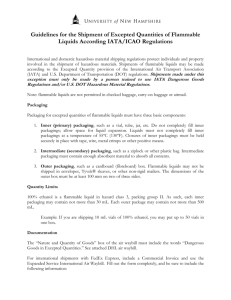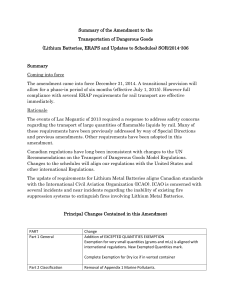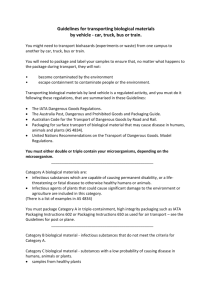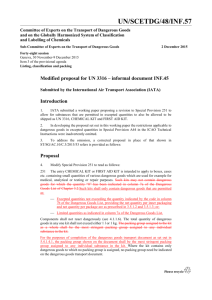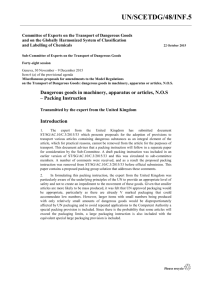un/scetdg/28/inf.40
advertisement
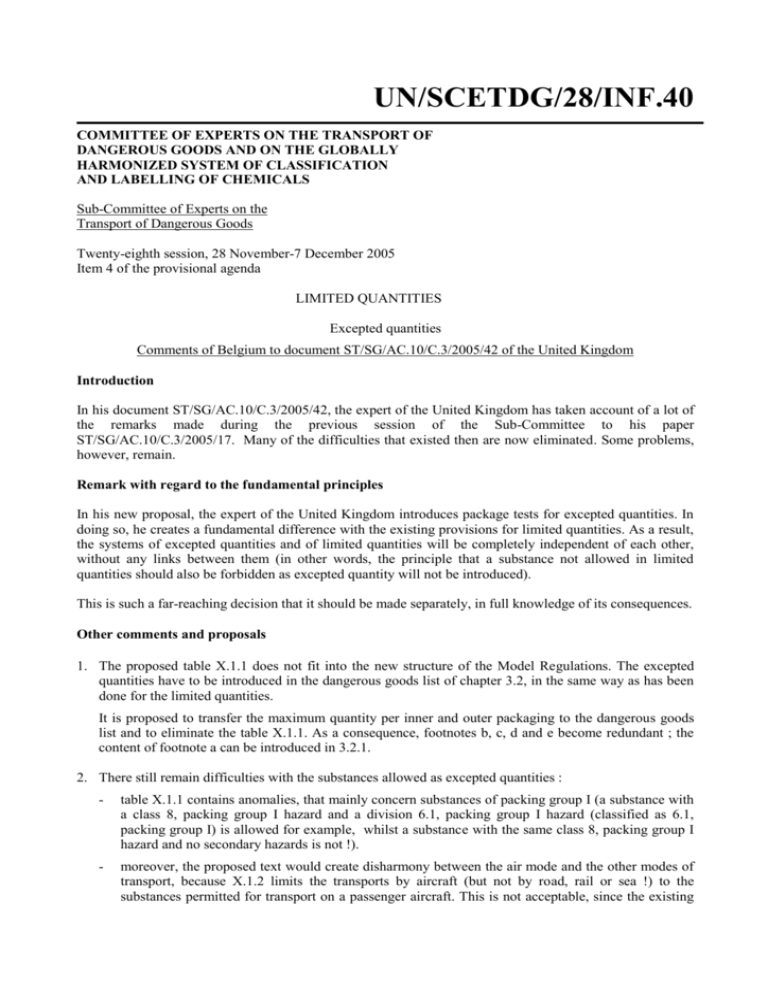
UN/SCETDG/28/INF.40 COMMITTEE OF EXPERTS ON THE TRANSPORT OF DANGEROUS GOODS AND ON THE GLOBALLY HARMONIZED SYSTEM OF CLASSIFICATION AND LABELLING OF CHEMICALS Sub-Committee of Experts on the Transport of Dangerous Goods Twenty-eighth session, 28 November-7 December 2005 Item 4 of the provisional agenda LIMITED QUANTITIES Excepted quantities Comments of Belgium to document ST/SG/AC.10/C.3/2005/42 of the United Kingdom Introduction In his document ST/SG/AC.10/C.3/2005/42, the expert of the United Kingdom has taken account of a lot of the remarks made during the previous session of the Sub-Committee to his paper ST/SG/AC.10/C.3/2005/17. Many of the difficulties that existed then are now eliminated. Some problems, however, remain. Remark with regard to the fundamental principles In his new proposal, the expert of the United Kingdom introduces package tests for excepted quantities. In doing so, he creates a fundamental difference with the existing provisions for limited quantities. As a result, the systems of excepted quantities and of limited quantities will be completely independent of each other, without any links between them (in other words, the principle that a substance not allowed in limited quantities should also be forbidden as excepted quantity will not be introduced). This is such a far-reaching decision that it should be made separately, in full knowledge of its consequences. Other comments and proposals 1. The proposed table X.1.1 does not fit into the new structure of the Model Regulations. The excepted quantities have to be introduced in the dangerous goods list of chapter 3.2, in the same way as has been done for the limited quantities. It is proposed to transfer the maximum quantity per inner and outer packaging to the dangerous goods list and to eliminate the table X.1.1. As a consequence, footnotes b, c, d and e become redundant ; the content of footnote a can be introduced in 3.2.1. 2. There still remain difficulties with the substances allowed as excepted quantities : - table X.1.1 contains anomalies, that mainly concern substances of packing group I (a substance with a class 8, packing group I hazard and a division 6.1, packing group I hazard (classified as 6.1, packing group I) is allowed for example, whilst a substance with the same class 8, packing group I hazard and no secondary hazards is not !). - moreover, the proposed text would create disharmony between the air mode and the other modes of transport, because X.1.2 limits the transports by aircraft (but not by road, rail or sea !) to the substances permitted for transport on a passenger aircraft. This is not acceptable, since the existing UN/SCETDG/28/INF.40 page 2 disharmony between the air mode and the other modes is the only reason for the introduction of these excepted quantities in the model regulations. It is to be noted that most packing group I substances would fall under this air mode limitation. It is therefore proposed not to accept packing group I substances as excepted quantities. 3. If table X.1.1 is retained (depending on the decision taken on proposal 1), - the gases of division 2.2 with subsidiary risk have to be introduced, with the indication “Not permitted” ; - all columns (except the first one) have to be eliminated for division 2.2 without subsidiary risk and for division 5.2 (there are no packing groups for these divisions) ; their content can be replaced respectively with : “Inner packagings : 30 ml Outer packagings 1 L” and “Inner packagings : 30 ml or 30 g Outer packagings 500 g or 500 ml”. 4. In X.1.1 (c), the general packaging provisions of 4.1.1.5 are not retained. This is correct for 4.1.1.5.1, but not for 4.1.1.5 itself. There the part concerning the orientation markings is superfluous, but not the rest (especially the statement that any leakage of the contents shall not substantially impair the protective properties of the outer packaging, since the proposed X.1.3 (b) is limited to the cushioning and absorbent material). It is proposed to replace X.1.3 (b) with : “(b) each inner packaging shall be securely packed in an intermediate packaging with cushioning material in such a way that, under normal conditions of transport, they cannot break, be punctured or leak their contents. The intermediate packaging shall completely contain the contents in case of breakage or leakage, regardless of package orientation. For liquid dangerous goods, the intermediate packaging shall contain sufficient absorbent material to absorb the entire contents of the inner packaging. In such cases, the absorbent material may be the cushioning material. The contents shall not react dangerously with cushioning, absorbent and packaging material or reduce the integrity or function of the materials ; “ 5. X.1.5 and X.1.6 are not mentioned in X.1.2, which would make them superfluous. Moreover, the provisions that are being proposed in X.1.5 and in X.1.6 are of little or no practical use. What is the benefit of excepted quantity shipments, when tested and marked packagings are needed, as well as the marking of the transport unit and a statement in a transport document ? The safety concerns that are at the basis of these paragraphs are better taken care of if a maximum limit per transport unit is introduced for the carriage of excepted quantities. Moreover, Belgium is of the opinion that a lower value than 1.000 kg gross weight is needed for safety reasons. It is proposed to replace “sections X1.3 and X1.4” in X.1.2 with “sections X.1.3, X.1.4 and X.1.5” (twice), and to replace X.1.5 and X.1.6 with the following : “X.1.5 Transport units shall not carry more than [100 kg] gross weight of dangerous goods in excepted quantities.” ____________
